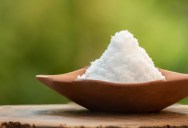How The Salt Cycle Is Going Wrong, And Why You Should Care

It’s tempting to believe that our world is totally chaotic, and that it’s hard to predict what problem (or huge development) will crop up next.
The truth is that a majority of events on Earth are predictable, and ruled by one cycle or another.
We have a water cycle, a solar cycle, and a dozen small orbits that combine to create the circle of life.
The salt cycle is how salts enter and interact with the natural world.
And just like in the human body, too much salt is not good.
That said, geology professor Sujay Kaushal says the right amount of salt is essential.
“We’re basically an electrical system, controlled by salts.”

Plants also rely on salts to aid their chlorophyll production, and in a larger sense, the planet itself needs salts to clump together soil.
“Salt has a small ionic radius and can wedge itself between soil particles very easily. In fact, that’s how road salts prevent salt crystals from forming.”
Natural salt forms through a cycle of movement, growth, precipitation, and more.
Salt comes from the Earth’s mantle, formed when tectonic activity exposes the magma to the ocean or the air. Then it solidifies into rock that is worn down by wind and rain, or is leached into the oceans via chemical reactions.
Salt ions are released into the soil, then taken up by plants and other organisms. Some may be washed away in rivers or blown by the wind or sea sprays.
In an ideal world, the salt gets eaten by plants and animals and ends up in the sea and soil again to start over.
Like so many other things on Earth, humans are negatively impacting the naturally occuring amounts of salt.
“Increasing salt production and use is shifting the natural balances of salt ions across Earth systems, causing interrelated effects across biophysical systems collectively known as freshwater salinization syndrome.”
The paper goes on to explain the effects humans have had.
“Anthropogenic activities have accelerated the processes, timescales and magnitudes of salt fluxes and altered their directionality, creating an anthropogenic salt cycle. Global sale production has increased rapidly over the past century for different salts, with approximately 300 Mt of NcCl produced per year.”

Salt no longer enters the salt cycle from natural processes alone, because it is extracted from food, road de-icing, acid rain, and salt-filled wastewater from agricultural and industrial processes – all created in some way by human beings.
It’s caused such a dramatic increase that researches are referring to is as the “anthropogenic salt cycle” – one produced by humans.
“If you think of the planet as a living organism, when you accumulate so much salt it could affect the functioning of vital organs or ecosystems.”
When the excess builds up in the ecosystem, there is a buildup of salts in the waterways, lakes, air, and soil.
Over the past 50 years, 2.5 billion acres of soil has been salinized to a degree researchers believe is problematic.
“When humans add salt to waterways, that salt also releases a lot of dangerous collateral chemicals.”
It contributes to things like the water crisis in Flint, MI and ongoing imbalances in a variety of ecosystems.
“It’s clear that regulatory agencies need to find new ways to address these ‘chemical cocktails’ released by saltier water rather than looking at individual freshwater pollutants one by one.”
Whether or not we can do anything to try to fix it remains to be seen.
“This is a very complex issue because salt is not considered a primary drinking water contaminant in the US, so to regulate it would be a big undertaking.”
Not only that, but they’re not sure removing it would really work, either.
“Removing salt from water is energy intensive and expensive, and the bring byproduct you end up with is saltier than ocean water and can’t be easily disposed of.”

The US is a huge offender, mostly due to their use of road salts. Washington DC has tried using beet juice to de-ice roads and has found it just as effective as salt on the roads.
As with most environmental issues, this one is pressing.
“There’s the short-term risk of injury, which is serious and something we certainly need to think about, but there’s also the long-term risk of health issues associated with too much salt in our water.”
There’s no doubt the buildup of salt is harmful.
What’s less clear is the best way to handle it.
If you thought that was interesting, you might like to read about why we should be worried about the leak in the bottom of the ocean.

Sign up to get our BEST stories of the week straight to your inbox.




